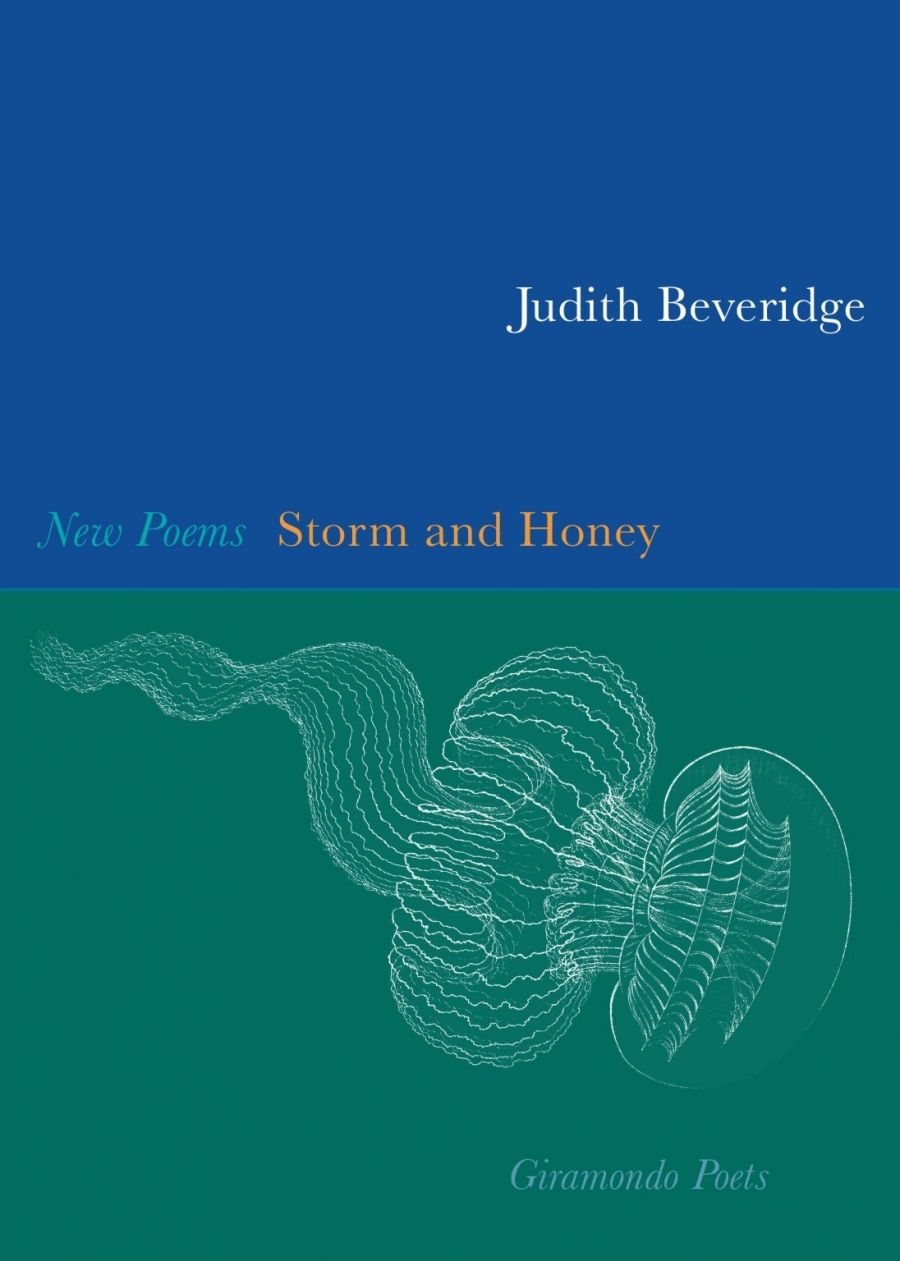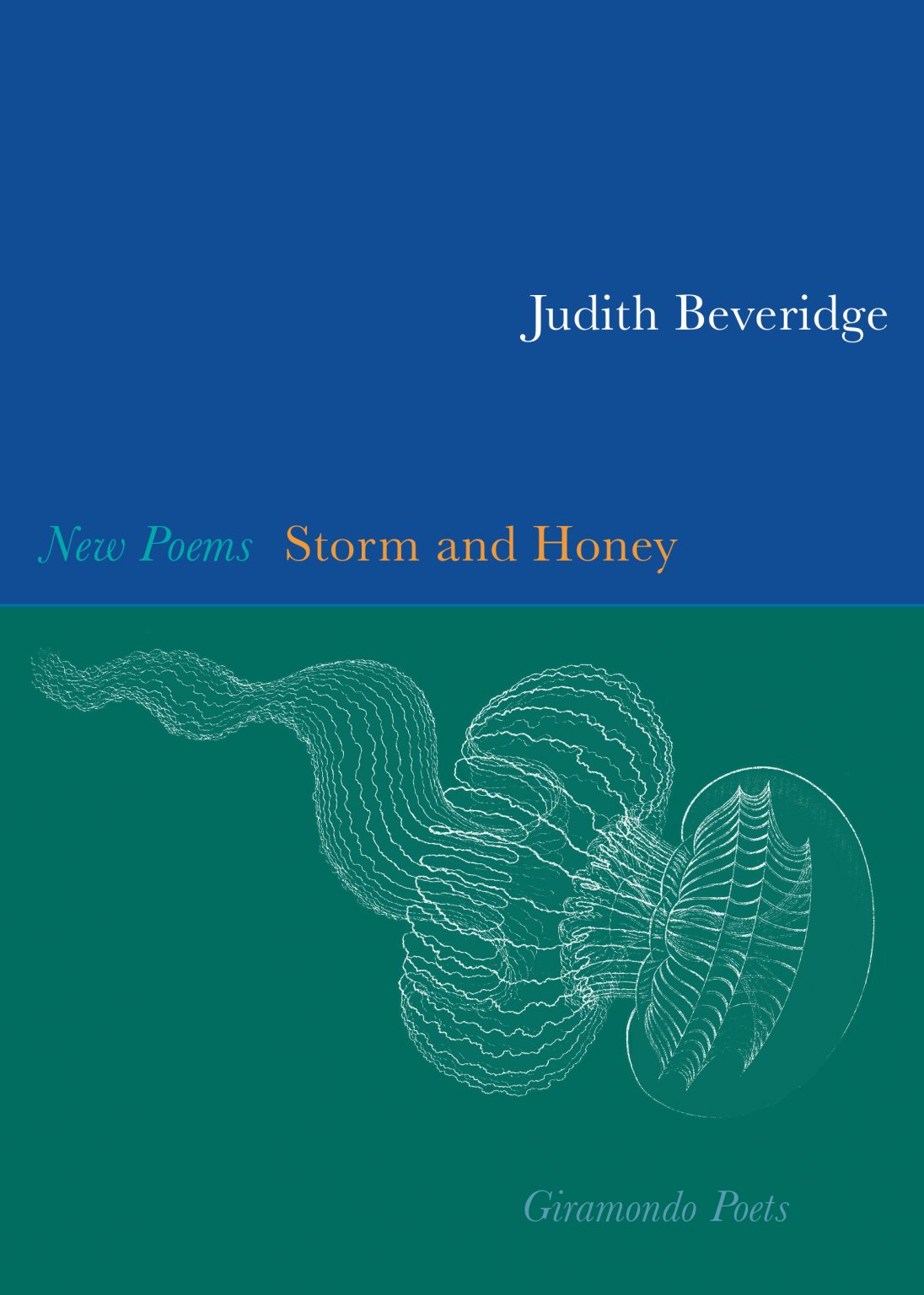
- Free Article: No
- Contents Category: Poetry
- Review Article: Yes
- Article Title: Reeling her line
- Online Only: No
- Custom Highlight Text:
Judith Beveridge is one of the most brilliant image-makers in Australian poetry. She writes of rain ‘bubble-wrapping the windows’ and yachts making a sound ‘as if cutlery were being replenished on table tops’. Her images, exuberant and fantastical, hold a balance between the real and the imagined world – as Gwen Harwood’s poem, ‘Thought Is Surrounded by a Halo’, closes: ‘Picture two lovers side by side / who sleep and dream and wake to hold / the real and the imagined world, / body by body, word by word …’
- Book 1 Title: Storm and Honey
- Book 1 Biblio: Giramondo, $22 pb, 96 pp
- Book 1 Cover Small (400 x 600):

For a start, these poems test the rhythm of a speaking voice against the formal patterning of Beveridge’s poetry. This works to good effect in ‘The Trawlers’, for instance, which starts: ‘The broken northern cliff face and tidal rips still / driving across the rocks …’ Here, and repeatedly in this poem, the line breaks create a pause before the meaning closes into place. The form of the poem works these small mechanisms of suspense, asserting the poem’s shape against the flow of its narrative.
Fastidious and detailed, these poems are also flamboyant with puns and alliteration: ‘the creaking clutch of the crank’; ‘the shiftings of shell and sand …’ This collection, Beveridge’s fourth, shows her working more playfully with words. For instance, in the second part, her poem ‘Sinner’s Marsh’ includes the words ‘sleechy’, ‘slurried’, ‘rotund’, ‘larval’, ‘oolong’, ‘clabber’ and ‘blebs’. The poem itself sounds marshy.
In ‘Driftgrounds: Three Fishermen’, the characters argue out this difference between wordplay and plain talk. Beveridge introduces them in a poem punningly called ‘The Cast’. The narrator, a wide-eyed word-monger, starts the poem: ‘I flick my line out …’ – punning again on the fishing line and line of the poem. Grennan is always in action: ‘Grennan casts out – a long / tearing sound. “One good cast will take you right // to where the fish prick the surface,” he says, and covers / another hook with a new section of prawn …’ Davey is paying attention: ‘he watches Grennan and me, listens to our reels, to his own // as he revolves it, cracks it, working at its precision, / desperately waiting for it to click part of himself into being.’ Here, the three characters suggest various ways of apprehend-ing experience and various elements at work in the writing of a poem.
This is the balancing act: to give these characters a sense of reality and to have them also figure in Beveridge’s exploration of how poetry works. The poems in this sequence maintain a sense of the fishermen’s actual work. They are full of tools: cranks, cables and wheels, reels, hooks and knives. One poem opens, ‘I drive my blade into the fish’s anal opening’, which would stand out in pretty much any poetry anthology’s index of first lines. But the poems are always balancing this sense of action against the way fishing in this sequence serves as an emblem of poetry: ‘I’ve been reeling in my line and casting out.’
Among these fishermen, the speaker is a fisher of poems, making up names for hooks – ‘wild-beaked bait-giver … ibis leaning / over the shallows … greenshanks / in flight …’ – because ‘the hooks’ real names … are just not poetry’. In this light, when the speaker says, ‘Soon I’ll ease down my head, pour / everything out, pack everything in; feel my dreams churn / like sea wrack at tide-turn, in the cold cut of the wind’, it works also as a description of writing poetry. In this way, Beveridge brings a quizzical distance to this closely detailed narrative, something akin to that detached perspective the speaker reaches in the poem ‘Spittle Beach’: ‘Men in the distance / are flicking lines out, they are spectred by the spume; / even the rocks and headland seem ghost-dreamt …’
Robert Frost once said that ‘the way to read a poem … is in the light of all the other poems ever written’. In Storm and Honey, Beveridge writes poems consciously in the light of other poems. She keeps always her own patient and fantastical style, but her poems here engage with other poems until poetry seems as much a term of existence as the landscape. In one poem, Beveridge quotes Robert Gray, another brilliant image-maker. She considers Judith Wright in her descriptions of herons, Gwen Harwood’s ‘The Sea Anemones’ in ‘Spittle Beach’, and the poetry of Anthony Lawrence and Robert Adamson in her descriptions of fishing. The collection works subtly, in this way, as a study of how poetry threads itself through experience.
More than all these, the American poet Elizabeth Bishop’s combination of exact detail and surprising imagery offers a starting point for these poems. Harold Bloom has famously written on the anxiety of influence, but Beveridge is working out something more subtle here: how, beyond any imagined relationship with the poets themselves, the poems which they have written come to exist for other poets as a medium of experience.
The title, Storm and Honey, comes from Kenneth Slessor’s poem, ‘Captain Dobbin’: ‘… for they were shipmates, too, / companions of no cruise by reading-glass, / but fellows of storm and honey from the past …’ After Virgil, the honeycomb has served as an image of poetry. In Shakespeare’s Pericles, Prince of Tyre – a play, incidentally, with three fishermen – Marina says, ‘This world to me is a lasting storm, / whirring me from my friends.’ By these reference points, Slessor’s phrase holds in balance wild time and the stored richness of poetry. It is this balance that interests Beveridge.


Comments powered by CComment